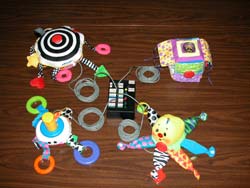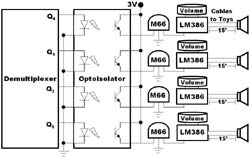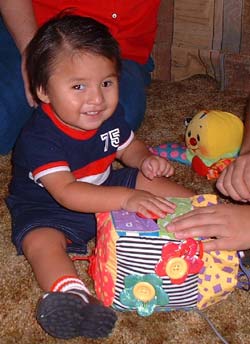Orientation Game for Visually Impaired Toddlers
ABSTRACT
We developed an orientation game for a sixteen-month-old boy with a genetic eye disorder called Leber's Congenital Amaurosis, which results in severe visual impairment (VI). As with many VI children, he learned to walk without first learning to crawl. However, crawling is vital to developing the upper body strength and coordination required to use a cane and read Braille. Our game consists of four music cubes placed in different areas of a room. When the user turns on the game, music starts playing from one of the cubes. When the toddler hits the switch on the cube, music begins to play from a different cube. The game gives VI toddlers an incentive to crawl and explore by playing music in different areas of a room.
KEYWORDS
Toddlers, motor development, visual impairment, orientation
BACKGROUND
Toddlers with visual impairment (VI) lack the visual incentive to explore their environment. For sighted toddlers, visible cues provide continuous incentive for early motor development. Audible cues, however, are discontinuous; during periods of silence, a VI toddler is unaware of his surroundings and there is no incentive to explore. Without visual cues, early motor skills, such as crawling, are delayed in VI toddlers despite physical readiness (1). Crawling is not only an important stage for motor skill development, but is also vital in building the upper body strength necessary to use a cane and read Braille.
Fraiberg concluded that motor skills development is delayed because babies with VI fail to understand that an object that makes a sound has physical source (2). Therapy is necessary to help the toddler associate the sound with its appropriate tactile stimulus. Once the toddler makes this connection, the toddler achieves what Fraiberg calls the “reach on sound” stage, a crucial phase of development for a toddler with VI. Once the toddler achieves this stage, higher motor skills will develop naturally (3).
PROBLEM STATEMENT
Our client is a sixteen-month-old boy with a genetic eye disorder called Leber's Congenital Amaurosis, which results in severe VI. The goal of this project was to develop a device that provides auditory incentive and tactile feedback to encourage both basic mobility and “reach on sound.”
DESIGN AND DEVELOPMENT
General Approaches and Design Selection
In the original design, a parent or therapist would place the four custom music cubes in a safe area, such as a crib or a playpen. When the user turned the game on, music would play from one of the four music cubes. This would encourage the toddler to approach and explore the cube. When the toddler hit a switch on the cube, a different song would start playing from a different cube that was randomly selected, encouraging the toddler to approach the next cube. This overall concept remains the same in the final design. After consulting with therapists and the client's family, we made several improvements from the initial design, which are outlined below.
A playpen inhibits a toddler's developing exploration skills. We decided that the music cubes should be placed around a room, rather than inside a playpen.
We added an “ordered mode” in addition to the “random mode.” In the ordered mode, the toddler becomes familiar with the orientation of the room by hearing the toys activate in a predetermined order. Once the toddler is familiar with the orientation of the room, the parent or therapist can switch the device to random mode so that the toys activate in a random sequence. The unpredictability adds excitement to the game.
 |
In our initial design, each sound cube consisted of a speaker and switch mounted inside a small project box. However, the VI toddler must make the connection that sound has a physical source. We wanted to emphasize this connection by associating a song with a tactile stimulating toy. Instead of a dull project box, we decided to enclose the speaker and switch inside commercial toys that include engaging tactile features, such as vibration, hidden noise makers, and buttons (Figure 1).
Circuitry
 |
 |
The next phase of the project involved designing the circuit. The game functions in two modes: 1) ordered mode and 2) random mode, as shown in Figure 2.
In random mode (Figure 2A), when the user presses a switch, the circuit activates a toy depending on the current value of the counter. Because the counter value changes rapidly, any one of the four demultiplexor outputs has an equal chance of selection.
In ordered mode (Figure 2B), when the user presses a switch, the circuit activates the next consecutive toy in the order 0, 1, 2, 3, 0, 1, 2, 3, ….
 |
In both modes (Figure 3), the outputs of the demultiplexor lead to optical-isolators, which activate melody generator chips. Each chip is preprogrammed with a particular song. The melody output is amplified by an audio amplifier and sent through a 15-foot cable to the corresponding toy, where it is played through a speaker. A potentiometer controls the volume.
AESTHETICS
The second phase of the project involved designing the control box and choosing proper toys to house the four speakers and switches.
A plastic project box houses the bulk of the circuit described above, as well as several user controls: the toggle on/off switch, the toggle “ordered/random mode” switch, and four potentiometers with audio taper to control the volume. The four toys plug into four audio jacks on the control box. Spanish labels were added to make the toy accessible to the Spanish-speaking client's mother.
Four commercial toys were adapted for this project. We added large red momentary switches and speakers to Dress and Discover Cube (Imagiix, Cincinnati, OH) and Mr. Whoozit (Manhattan Toy, Minneapolis, MN). A switch was added to Touch and Squiggle Sammy (Fisher-Price, East Aurora, NY); we used the pre-existing speaker in Sammy to output our own music. Pressing Sammy's nose causes the toy to vibrate. The Stacking Surprise Octopus (Fisher-Price, East Aurora, NY) contained both a pre-existing speaker and switch. We removed the circuit board from the toy and adapted the connections for our use. A 15-foot cable with a male audio plug connects each toy to the control box and allows a versatile placement of the toys around a room. Each toy can be safely connected to a piece of furniture such as a table, chair, or couch leg using the Velco strap attached to the cable. Any of the four toys can plug into any of the four audio jacks on the control box.
EVALUATION
 |
The device was donated to the client's family. The toddler (Figure 4) loved playing with the different toys and the project worked as intended. His preschool teacher, mother, and therapist were all very pleased with the device and the client's response to the different audio and tactile stimuli.
DISCUSSION AND CONCLUSION
The client really enjoyed playing with the orientation game. He perked up and smiled as the different songs played. He quickly learned that pressing the switches on the different toys causes the songs to change. The following quote from the client's preschool teacher best describes the project's success:
The orientation game is an innovative and creative way for a child who is visually impaired to develop auditory localization skills and to be motivated to move out into the environment to locate the sound. The toys are a wonderful reward for the grand effort involved in moving across space, and finding the toy that cannot be seen. This game can also easily be adapted to create more developmentally challenging activities for Victor as he gets older.
ACKNOWLEDGMENTS
Funding for this project was provided by NSF Grant BES-9981867, the UNC Ueltchi Service Learning Grant, and the Smallwood Foundation. We extend our heartfelt gratitude to Richard Goldberg, our advising professor, and other UNC faculty: Gary Bishop, Hugon Karwowski, and Sean Washburn. We also wish to thank orientation and mobility therapist Dianne Brauner, VI teacher Susan Puckett, and UNC student John Dumas.
REFERENCES
- Fraiberg S. Separation crisis in two blind children. Psychoanalytic Study of the Child 1971. 26:355-371.
- Elisa F, Josée L, Oreste F-G, Claudia A, Antonella L, Sabrina S, Giovanni L. Gross motor development and reach on sound as critical tools for the development of the blind child. Brain and Development 2002. 24:269-275.
- Levtzion-Korach O, Tennenbaum A, Schnitzer R, Ornoy A. Early motor development of blind children. Journal of Paediatric Child Health 2000. 36:226-229.
AUTHOR CONTACT INFORMATION
Christa Wheeler,
University of North Carolina at Chapel Hill,
144B MacNider Hall CB#7575,
Chapel Hill, NC 27599
Cell Phone (919) 260-7490
EMAIL: cwheeler@email.unc.edu
